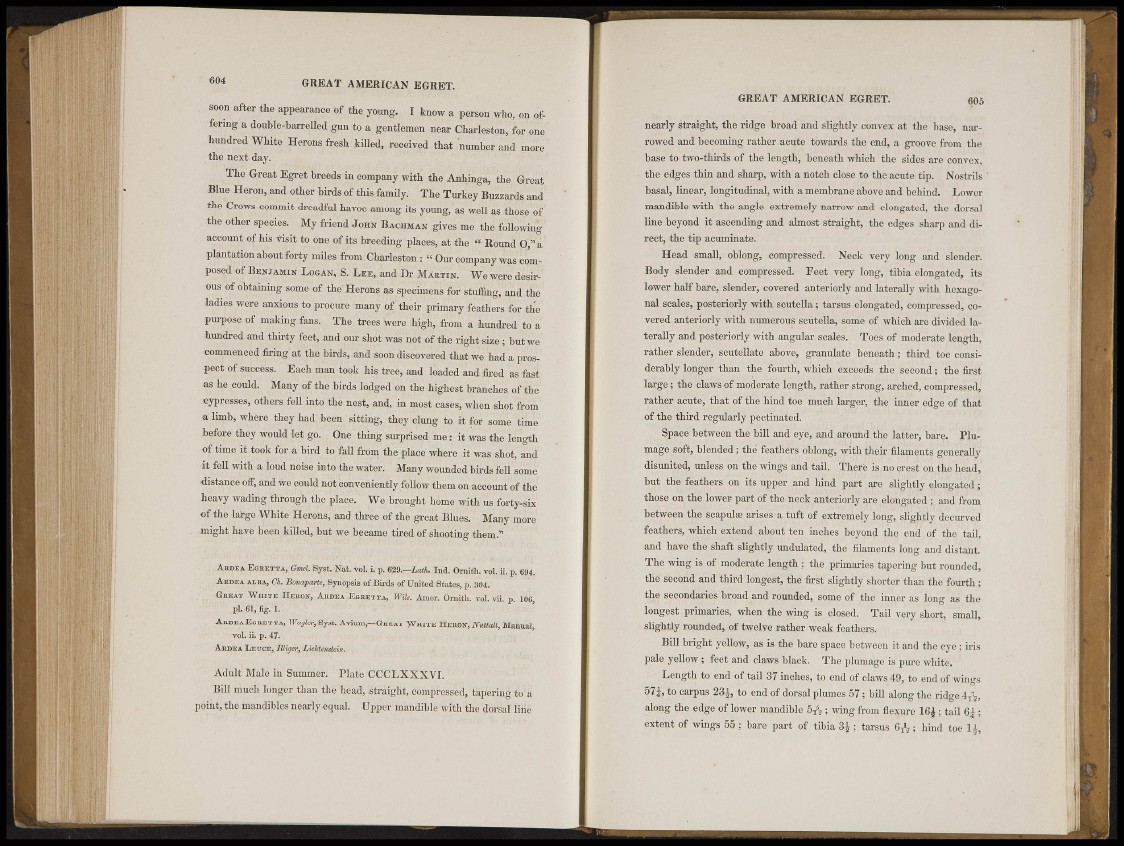
604 GREAT AMERICAN EGRET.
. soon after the appearance of the young. I know a person who, on offering
a doubfe-barrellod gun to a, gentlemen near Charleston, for one
hundred White Herons &gsh killed, received that number and more
the next day, .
The Great Egret breeds m company with the Anhimga, the ¿reat
Blue Heron, and other birds of this family. The Turkey Buzzards and
the Crows commit dreadful havoc among its young, as well as those of
the other species. My friend John Bach.max gives me .the following"
account of his «sit to one of its breeding plaoes, aï the " Round G,'"a
plantation about forty miles from: Charleston. : " Our company was composed
Of Benjamin Losàn, S. Lie», and Br Mabtim. We were désirons
of Obtaining ;some of the Herons as specimens for staffing,, and the
ladies were anxious to procure many of' their primary feathers for l i e
purpose of making fans. The trees Were high, ¡from a hundred to a
hundred and thirty feet, and our shot was not of.the right size ; butwe
commenced firing at thè birds, and soon discovered that w® had a prospect
of «uccêss. Each man took his tree, and loaded and fired as fast
as he could. Many of thé birds lodged on the highest branches of the
•cypresses, others fell into the nest, and, in most cases, when shot from
a limb, where they had been sitting, they clung to it for some time
.before they would>t go. One thkg surprised me : it was the length
of time it took for a bird to fall from Ou; place where it was shot, and
it fell with a loud noise iato the. water. Many Wounded birds fell some
distance off, and we could not conveniently follow them on account of the
heavy wading through the; place. We brought home with: us forty-six
of the large White lierons, and three of thè great liluos. Many more
might have been killed, but we beeame tired of shooting them."
Ahdea K«rktta, Ctutl, Syst. Nat. vol. i. p. !»!>.- l.ith. Did. Orniti, vol. ii. p, 694.
MmnA alba, Gh. Bdna^mtt,Bpii>^As of Biris of ¡CiritediStates, p. 804.
Great White Heuok, Ardea -Kore ita, » ;•'.•. Amer. Ormili, vol. vii. p. 106
jil. (¡1, %. 1. '
Ardea Egretta, Wôgterî<ê$it. Avìu.»i,-Gkkat >Viutk Heron, WnttaU, Manual,
' . vol. ii. p. 47.
Ardea Leuce, llli/jer„ Lkhtenztein.
Adult Malé in Summer. ' l'Iato CCCLXXXVI. '
Bill'much longër than thé head, Straight,-compressèâ, tapering toa
.p.ôint, the mandibles nearly equal. Upper mandiblé with the dorsal line
GREAT AMERICAN EGRET. 605
nearly straight, the ridge broad and slightly convex at the base, narrowed
and becoming rather acute towards the end, a groove from the
base to two-thirds of the length, beneath which the sides are convex
the edges thin and sharp, with a notch close to the acute tip. Nostrils
basal, linear, longitudinal, with a membrane above and behind. Lower
mandible with the angle extremely narrow and elongated, the dorsal
line beyond it ascending and almost straight, the edges sharp and direct,
the tip acuminate-
Head small, oblong, compressed. Neck very long and slender.
Body slender and compressed. Feet very long, tibia elongated, its
lower half bare, slender, covered anteriorly and laterally with hexagonal
scales, posteriorly with scutella; tarsus elongated, compressed, covered
anteriorly with numerous scutella, some of which are divided laterally
and posteriorly with angular scales. Toes of moderate length,
rather slender, seutillate above, granulate beneath; third toe considerably
longer than the fourth, which exceeds the second; the first
large; the claws of moderate length,, rather strong, arched, compressed,
rather acute, that of the hind toe much larger, the inner edge of that
of the third regularly pectinated.
Space between the bill and eye, and around the latter, bare. Plumage
soft, blended; the feathers oblong, with their filaments generally
disunited, unless on the wings and tail. There is no crest on the head,
but the feathers on its upper and hind part are slightly elongated;
those oh, the lower part of the neck anteriorly are elongated ; and from
between the scapulae arises-a tuft of extremely long, slightly decurved
feathers, which extend about ten inches beyotul the end of the tail,
and have the shaft slightly undulated, the filaments long and distant
The wing is of moderate length; the primaries tapering but rounded,
the second and third longest, the first slightly shorter than the fourth;
the secondaries broad and rounded, some of the inner as long as the
longest primaries, when the wing is closed. Tail very short, small,
slightly rounded, of twelve rather weak feathers.
Bill bright yellow, as is the bare space between it and the eye; iris
pale yellow; feet and claws black. The plumage is pure white.
* Length to end of tail 37 inches, to end of claws 49, to end of wings
57i, to carpus 23|, to end of .dorsal plumes 57; bill along the ridge
along the edge of lower mandible 5A; wing from flexure 16J; tail 6£;
extent of wings 55 ; bare part of tibia 3 | ; tarsus hind toe